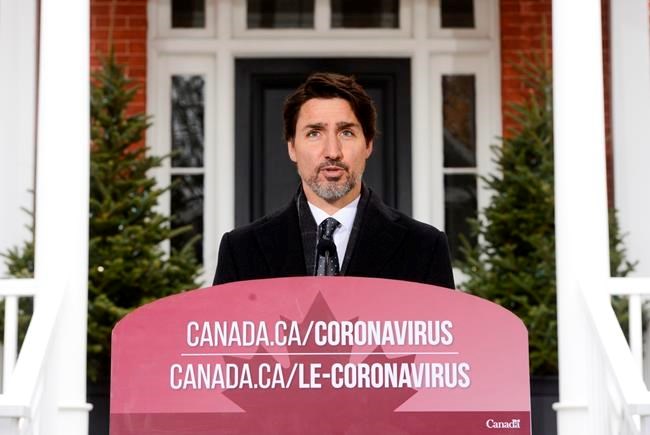OTTAWA — The federal government is speeding up financial help to low-income earners hit by the COVID-19 pandemic, with payments through the GST credit a month sooner than planned as it prepares to deliver billions more on benefits beginning next week.
The government initially announced the money through the GST credit would be available in May, but Prime Minister Justin Trudeau said Friday that the money will be delivered this month.
Every qualifying adult will receive up to $300, plus $150 for each child. The parliamentary budget officer estimated in a report this week that the special GST credit payment will go to 13.2 million people and cost $5.67 billion.
More help is expected to arrive this month in the form of a new emergency benefit valued at $500 a week for up to 16 weeks.
An association representing Canada's banks said they will help clients enrol for direct deposit from the Canada Revenue Agency, or update their account information with the federal agency, to speed up payments of federal financial aid.
Similar requests have gone out to businesses to sign up for direct deposit for prompt payments of a promised 75-per-cent wage subsidy, saving the time it takes to issue and process cheques.
Speed has been a thread through the economic shock from COVID-19 — how fast economic activity slowed down, the race to set up federal assistance programs, and now a drive to get money into people's pockets quickly.
More than 2.1 million people have filed EI claims in the last two weeks, marking a dramatic shift in the labour force as economic activity is put on hold so people can avoid being in close contact to curb the spread of COVID-19.
A report Friday from RBC suggested the emergency benefit should fully replace or even exceed lost wages for hundreds of thousands low-income workers in the hard-hit retail, accommodation and food-services sectors.
Online applications for the Canada Emergency Response Benefit (CERB) open April 6, and anyone already approved for employment insurance benefits is supposed to be automatically moved over to the new benefit with no need to reapply.
MPs on the House of Commons finance committee were told Thursday that many of those who are receiving EI will get a bump in payments when they are moved to the emergency benefit, on average about $200 more per week.
Receiving the emergency benefit won't affect EI eligibility, meaning the 16 weeks won't count against the time an eligible worker can receive EI benefits.
On Friday, the committee was warned about public confusion over CERB eligibility, which requires a total loss of income due to COVID-19. But someone who was already looking for a job and hasn't stopped working due to COVID-19 is ineligible.
"It's not very clear because most people are, in theory, in the labour market, they want to be in the labour market, but there are no jobs to be had," Sherri Torjman, former vice-president of the Caledon Institute of Social Policy, in her opening comments.
Similar issues were raised in a letter the Opposition Conservatives sent Employment Minister Carla Qualtrough. Party critic Dan Albas cited contradictory statements between Liberal cabinet ministers and the government's website on automatic enrolment for the CERB, as well the effect on students and seasonal workers, and on EI premiums in the future.
"During a crisis, government communications must be clear, consistent and transparent," Albas said in a release. "This has not been the case over the past few weeks."
The RBC report, written by senior economist Andrew Agopsowicz, said many students won't meet the requirement of having made at least $5,000 in the previous year needed to qualify for the CERB.
Speaking at a midday press conference, Treasury Board President Jean-Yves Duclos said officials are smoothing out the rough edges of the program so that, for instance, volunteer firefighters or municipal politicians receiving honorarium payments aren't cut off from the CERB.
Asked about students, Duclos said the promised wage subsidy would help companies hire students who may have otherwise faced a difficult job market.
While the subsidy should help some of employers rehire laid off or furloughed workers, many may still find the program "won't be worth it" if it means they also have to pay the remaining 25 per cent, plus EI and Canada Pension Plan premiums, wrote CIBC chief economist Avery Shenfeld.
"An airline that isn't flying doesn't need flight attendants, a restaurant that's closed doesn't need waiters. For higher-paid workers, the subsidy covers even less of the cost," he wrote in a research note Friday.
Finance Minister Bill Morneau has hinted at more help above the $250-billion-plus in aid already announced — $105 billion of which is direct spending — and no cap on what the government might do. With an already projected deficit of $28.1 billion, it's possible the deficit this fiscal year could be as deep as $180 billion, said BMO chief economist Douglas Porter.
"What choice do we really have, given the mandated shutdown of the economy?" he wrote in an end-of-week report.
"It's much better that Ottawa shoulders the burden of almost all new spending than a hodge-podge effort by the provinces, especially in light of lower borrowing costs for the federal government."
This report by The Canadian Press was first published April 3, 2020.
Jordan Press, The Canadian Press

